2. 中国石油集团东北炼化工程有限公司吉林设计院, 吉林 132000
2. Jilin Design Institute, CNPC Northeast Refining & Chemical Engineering Co., Ltd., Jilin 132000, China
地下水有机污染日益严重[1, 2, 3, 4, 5],修复技术的研发及技术有效性分析逐渐成为污染场地修复领域研究的热点. 目前研究较多的修复技术有P&T(pump and treat,抽出-处理技术)[6,7]、 PRB(permeable reactive barrier,可渗透反应墙技术)[8,9]、 AS(air sparging,原位空气扰动技术)[10,11]、 SVE(soil vapor extraction,土壤气相抽提技术)[12]、 BS(biosparging,生物曝气修复技术)[13]、 MNA(monitored natural attenuation,监测自然衰减)[14]等,其中原位修复技术因其对场地环境扰动小,修复成本低等特点,得到了广泛应用. GCW(groundwater circulation well,地下水循环井技术)[15, 16, 17]作为一种原位修复技术,因其特殊的双井屏结构,能够在循环井周围形成地下水三维循环,通过有机物和氧气在气水两相间的传质作用,去除挥发性和半挥发性有机物,同时提高地下水中的溶解氧含量,强化原位好氧生物降解. 该技术早期研究集中于循环井结构的改进[18],地下水的循环方式[19],地下水三维流场的模拟[20]等,以上研究为循环井的场地应用奠定了基础[21, 22, 23].
循环井在国内尚处于起步阶段,白静等[24,25]研究了循环井技术对含水层中典型NAPL物质的修复效果,赵素丽等[26,27]利用GCW进行了生物修复,主要研究了技术的有效性,对于修复过程中循环井运行参数的选择优化、 污染物的去除规律以及最佳修复时间等,尚未开展详细的研究. 针对上述情况,本研究以中砂为实验介质,以硝基苯作为目标污染物,在二维模拟槽中进行运行参数优化及修复实验,以期为循环井场地应用提供理论参考.
1 材料与方法 1.1 实验材料中砂粒径:0.25~0.5 mm,孔隙度35.6%,有机质含量为0.33%,pH为7.15. 渗透系数为0.000 3 m ·s-1. 硝基苯为分析纯,25℃下,水相溶解度1797 mg ·L-1,亨利系数31.8 Pa ·m3 ·mol-1,蒸气压为32.66 Pa(0.245 mm Hg柱).
1.2 实验装置实验在二维有机玻璃模拟槽中进行,模拟槽尺寸为:130 cm×30 cm×60 cm(长×宽×高),模拟槽正面分布60个取样口,由左向右,由上向下分别为第1~10排和第1~6列(图 1). 以槽左侧布水板为位置零点,第1~10列与其垂向距离l分别为3、 16、 29、 42、 55、 68、 81、 94、 107和120 cm. 循环井以滤布包裹,与槽底部接触,垂直安置在槽中心位置. 中砂分层装入不断夯实,填装高度55 cm. 每个取样口埋设玻璃管,并以乳胶管与玻璃测压管连接,将所有的测压管粘贴在模拟槽体上,以指示每个取样点的水位变化. 在槽左侧布水区以蠕动泵缓慢进水,逐渐驱替介质孔隙中的空气,待地下水水位上升至一定高度后,停止进水并静置一段时间.
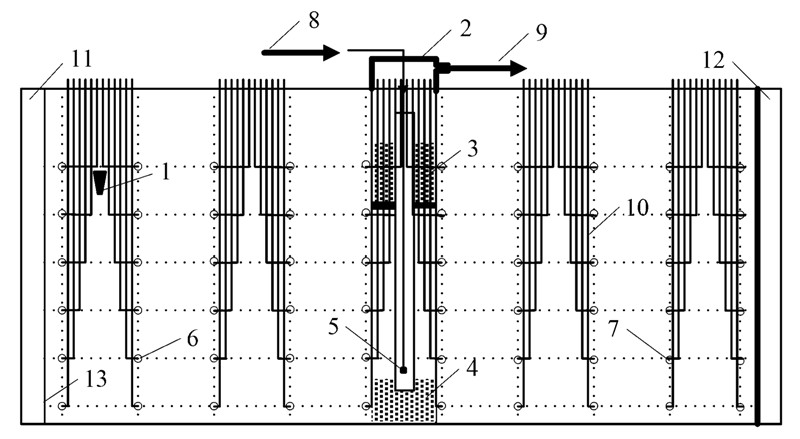 | 图 1 模拟装置示意Fig. 1 Schematic diagram of simulator 1.污染物泄漏槽; 2.地下水循环井; 3.上部穿孔花管; 4.下部穿孔花管; 5.曝气头; 6. 9号取样口; 7. 44号取样口; 8.洁净空气; 9.尾气; 10.测压管; 11.布水区; 12.出水区; 13.布水板 |
实验考察了地下水初始水位,曝气量和地下水流速对循环井运行效果的影响. 地下水初始水位影响实验:地下水初始水位分别为50、 45和40 cm,曝气量采用0.7 m3 ·h-1; 曝气量影响实验:固定地下水初始水位45 cm,曝气量为0.5、 0.6、 0.7和0.8 m3 ·h-1; 地下水初始流速影响实验:固定出水区水位高度为45 cm,调整进水区水位高度,使地下水流速为0.2、 0.4、 0.8、 1.0 m ·d-1,曝气量选用0.7 m3 ·h-1. 在各影响因素实验中,通过记录曝气前后测压管内水位高度变化,定量表征其对循环井运行的影响.
1.3.2 硝基苯修复实验控制地下水初始流速为0.2 m ·d-1,在模拟槽第1、 2列中间,地下水水位以上2 cm处,设置污染物泄漏槽. 泄漏槽底部以滤纸衬底,硝基苯的饱和溶液以一定流速缓慢泄漏,在不同时间取样,分析硝基苯的迁移规律. 待整个模拟槽被全部污染后,切断污染源,同时启动地下水循环井进行静水条件下的修复. 在不同累积曝气时间下,取水样测定硝基苯的浓度. 实验在相对密闭的室内进行,室内温度控制在25℃左右. 水样以三氯甲烷萃取,利用岛津2010型气相色谱定量分析. 色谱条件:DB-1色谱柱(30 m×0.25 μm×0.25 mm),FID检测器,进样量2 μL,分流比1 ∶5. 升温程序:40℃保持2 min,以2℃ ·min-1的速率升至80℃,保持3 min.
2 结果与讨论 2.1 循环井运行影响因素分析 2.1.1 地下水初始水位影响0.7 m3 ·h-1曝气量、 不同地下水初始水位条件下,循环井运行稳定后各测压管内的水位高度变化h如图 2所示. 结合实验现象可知:地下水初始水位为50 cm,循环井内水位上升过高过快,地下水由尾气口溢出. 地下水初始水位为45 cm和40 cm时,曝气后第1、 2和3排测压管内水位上升,第4、 5和6排则下降. 距离循环井越近,水位高度变化幅度越大. 通过各测压管内的水位变化可以推断,在模拟槽下部,地下水流向循环井,在模拟槽上部,地下水流出循环井,经过持续曝气,最终在循环井周围形成地下水的三维循环. 45 cm对应测压管内的水位高度变化幅度大于40 cm,说明其形成的地下水循环强度较强. 因此,地下水初始水位选为45 cm.
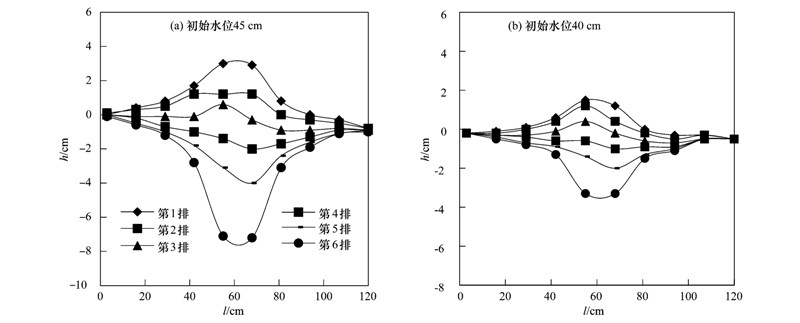 | 图 2 不同地下水初始水位测压管内水位高度变化Fig. 2 Groundwater level variations of piezometer tubes at the condition of different initial groundwater table |
图 3为45 cm地下水初始水位,0.5~0.8 m3 ·h-1曝气量下,各测压管内的水位高度变化. 由图 5可知,随着曝气量增加,各测压管内的水位变化幅度逐渐增大,地下水的循环强度逐渐增强,但当曝气量超过0.7 m3 ·h-1后,测压管内的水位变化幅度不再明显. 因此本实验选用0.7 m3 ·h-1作为最佳曝气量.
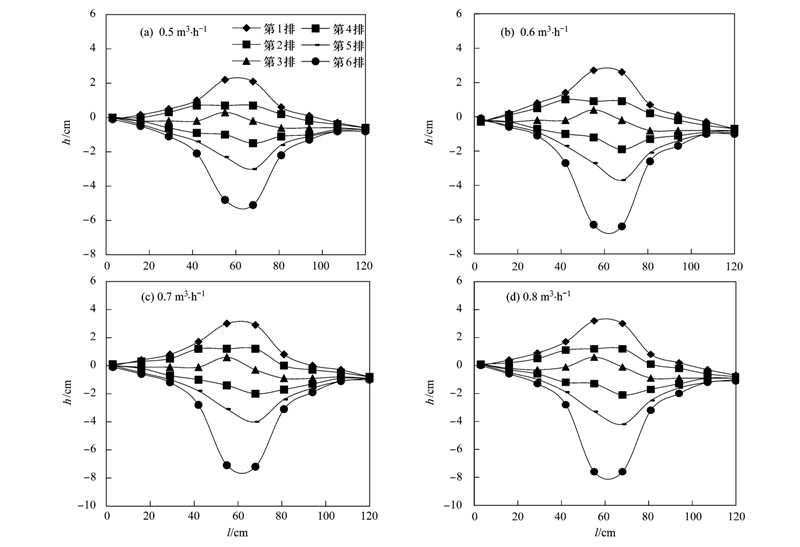 | 图 3 不同曝气量各测压管内水位高度变化Fig. 3 Groundwater level variations of piezometer tubes at the condition of different aeration rate |
不同的污染场地,地下水的流速往往也存在较大差异. 图 4给出了曝气量0.7 m3 ·h-1,不同地下水初始流速下,各测压管内的水位高度变化. 从中可知,各测压管内的水位变化幅度基本不发生变化,但较静水条件略有上升. 因此地下水初始流速在低于1.0 m ·d-1范围内时,对循环井运行的影响可忽略不计.
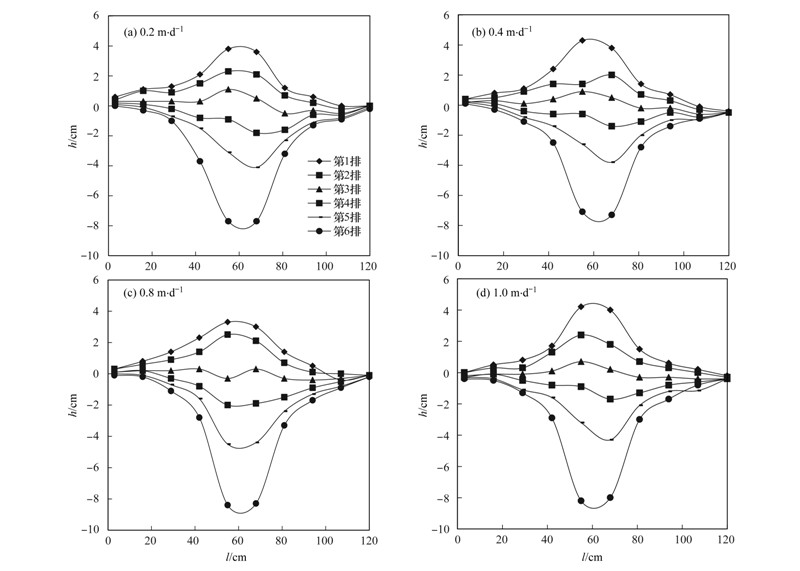 | 图 4 不同地下水初始流速测压管内水位高度变化Fig. 4 Groundwater level variations of piezometer tubes at the condition of different groundwater flow velocity |
有机物泄漏进入地下水后,会形成污染物的羽状体,并随着地下水的迁移不断增大. 由图 5可知,硝基苯的纵向迁移距离明显大于横向. 污染第10 d时,100.00 mg ·L-1的硝基苯浓度迁移锋面的最大纵向迁移距离为70 cm,而最大横向迁移距离为20 cm左右,仅为纵向迁移距离的29%,迁移距离的显著差异表明:有机物进入地下水后,迁移主要受对流弥散作用影响,随地下水流动是污染物羽状体持续增大的主要原因. 随着泄漏时间的延长,硝基苯的污染羽逐渐增大,污染至第50 d时,整个模拟槽被全部污染,此时模拟槽内硝基苯的最高浓度和平均浓度分别为499.78 mg ·L-1和246.97 mg ·L-1.
 | 图 5 不同泄漏时间下硝基苯浓度分布Fig. 5 Nitrobenzene concentration distribution at different leakage time |
图 6为硝基苯在修复过程中的浓度变化. 随着曝气时间延长,硝基苯浓度持续下降; 靠近循环井的硝基苯被优先去除,逐渐形成一个以循环井为中心轴的锥形修复区域.
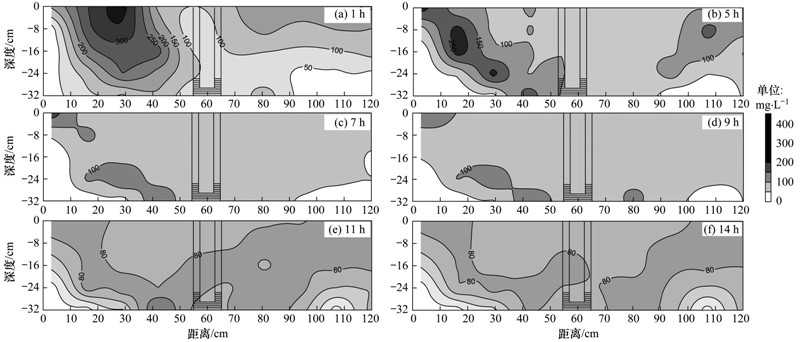 | 图 6 不同累积曝气时间硝基苯的浓度分布Fig. 6 Nitrobenzene concentration distribution at different accumulated aeration time |
硝基苯的去除大致经历了3个阶段(见图 6):曝气初期的3 h内,硝基苯的最高浓度和平均浓度大幅下降,分别为274.80 mg ·L-1和87.55 mg ·L-1,平均去除速率为0.89 mg ·(L ·min)-1,这主要是由于曝气初期,地下水中硝基苯浓度较高,气水两相间传质作用大的缘故; 累积曝气时间3~9 h范围内,硝基苯进入波动下降阶段,此时硝基苯的最高浓度和平均浓度分别降至140.19 mg ·L-1和80.54 mg ·L-1,平均去除速率为0.12 mg ·(L ·min)-1,原因可能是靠近循环井的硝基苯被去除后,液相中有机物浓度显著下降,但远离循环井区域内的硝基苯不能随着地下水快速迁移至循环井周围,从而造成硝基苯在气液两相间传质作用受阻; 累积曝气9~14 h内,由于环境介质的吸附作用等,硝基苯进入浓度拖尾阶段,持续曝气14 h后,地下水中硝基苯的最高浓度和平均浓度较第2阶段,仅降低了42.29 mg ·L-1和9.35 mg ·L-1,残余的硝基苯基本上分布在远离循环井,模拟槽的两侧区域.
以各列为研究单元,将曝气前后各列取样口硝基苯的浓度平均值作为c列0和c列,两者的拟合方程见表 1.
| 表 1 各列硝基苯平均浓度衰减方程Table 1 Concentration decay fitting equation of nitrobenzene in each column |
各拟合方程的系数为该列硝基苯的浓度衰减系数,由表 1可知,距离循环井越近,衰减系数越高,说明硝基苯的修复效果越好.
以9号和44号取样口为例,分析硝基苯的残留规律. 由图 7可知,曝气前3 h内,9号和44号取样口处硝基苯的浓度快速下降,累积曝气第3 h时,2个取样口处硝基苯的浓度分别为45.93 mg ·L-1和9.56 mg ·L-1; 之后缓慢上升,在累积曝气第7 h时,浓度上升达到峰值,分别为111.24 mg ·L-1和67.45 mg ·L-1; 之后缓慢下降,累积曝气14 h时,2个取样口处硝基苯的残留浓度分别为79.04 mg ·L-1和57.33 mg ·L-1.
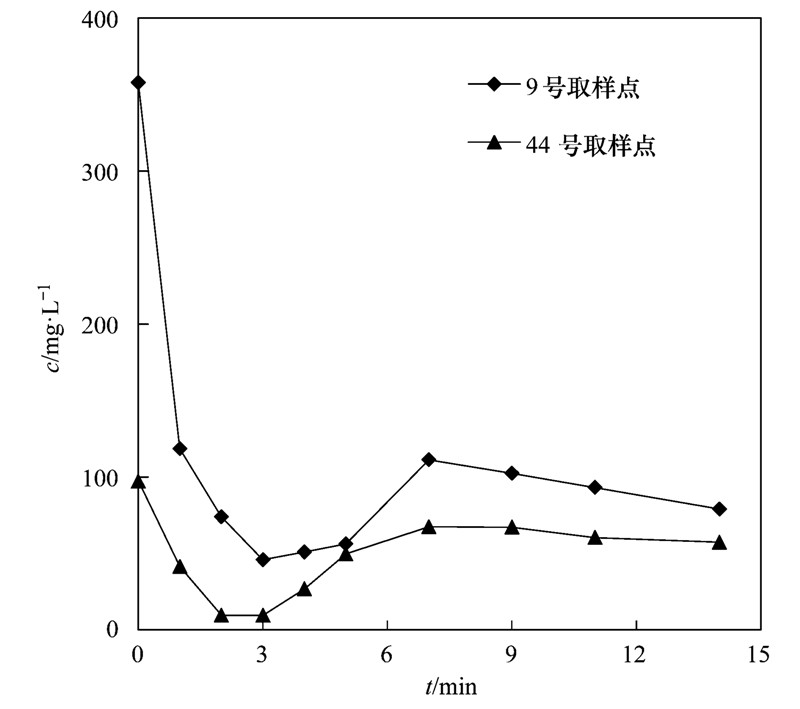 | 图 7 9号和44号取样口处浓度变化Fig. 7 Concentration variation trend of sampling points No. 9 and No. 44 |
结合衰减系数及2个取样口的浓度变化可知:靠近循环井的区域,有机物浓度持续下降,为循环井高效修复区域; 高效修复区域外,存在过渡区域,该区域内有机物浓度快速下降-缓慢上升-缓慢下降,有机物最终浓度受有机物吸附/解吸和迁移性共同影响.
以曝气前硝基苯的平均浓度作为c0,不同累积曝气时间下硝基苯的平均浓度作为c,c/c0与累积曝气时间关系如图 8所示. 从中可知,累积曝气时间超过9 h后,硝基苯的去除不再明显. 因此,在利用地下水循环井技术修复硝基苯类物质时,需要明确有机物的快速去除阶段,减少无用能耗,同时针对修复后期的拖尾现象,考虑使用其他技术联合修复.
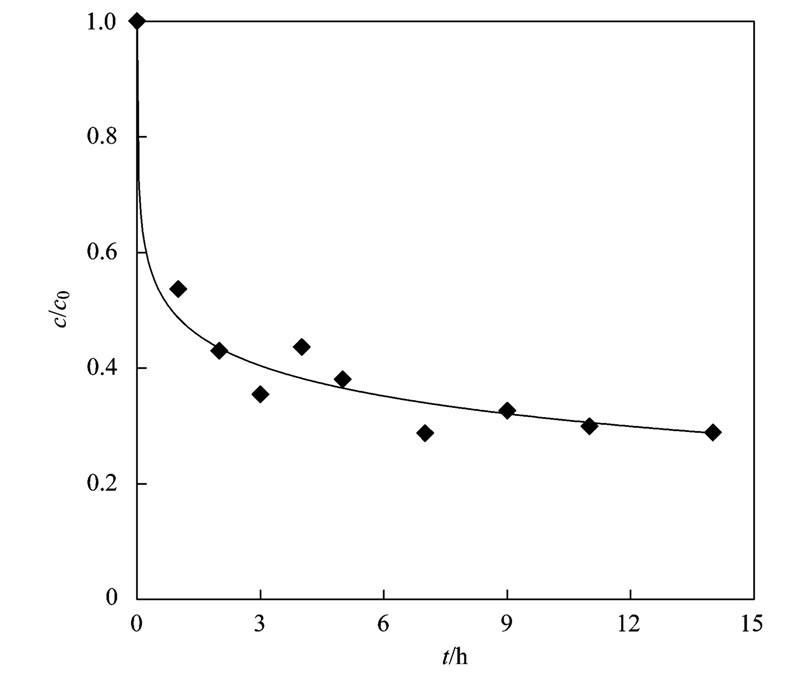 | 图 8 不同曝气时间硝基苯相对平均浓度Fig. 8 Variation trend of relative concentration of nitrobenzene at different aeration time |
(1) 地下水初始水位45 cm,曝气量为0.7 m3 ·h-1,地下水初始流速低于1.0 m ·d-1,地下水循环井能够达到良好运行状态.
(2) 硝基苯污染羽状体在地下水中不断迁移增大,其浓度锋面的纵向迁移距离明显快于横向迁移; 污染第50 d时,整个模拟槽被全部污染,硝基苯的平均浓度达到246.97 mg ·L-1.
(3) 靠近循环井的硝基苯被优先去除,逐渐形成一个以循环井为中心轴的锥形修复区域,硝基苯的去除经历了快速去除-波动去除-浓度拖尾这3个阶段,残留的硝基苯分布在远离循环井的区域; 循环井修复硝基苯污染地下水,存在最适修复时间.
| [1] | Loos R, Locoro G, Comero S, et al. Pan-European survey on the occurrence of selected polar organic persistent pollutants in ground water[J]. Water Research, 2010, 44 (14): 4115-4126. |
| [2] | 石建省, 王昭, 张兆吉, 等. 华北平原地下水有机污染特征初步分析[J]. 生态环境学报, 2011, 20 (11): 1695-1699. |
| [3] | 朱菲菲, 秦普丰, 张娟, 等. 我国地下水环境优先控制有机物的筛选[J]. 环境工程技术学报, 2013, 3 (5): 443-450. |
| [4] | 王晓红, 魏加华, 成志能, 等. 地下水有机污染源识别技术体系研究与示范[J]. 环境科学, 2013, 34 (2): 662-667. |
| [5] | 高存荣, 王俊桃. 我国69个城市地下水有机污染特征研究[J]. 地球学报, 2011, 32 (5): 581-591. |
| [6] | Singh A K, Tiwary C B, Singh B K. Groundwater organic contamination with limited efficiency of pump and treat remediation[J]. Research and Reviews: Journal of Ecology and Environmental Sciences, 2013, 1 (1): 1-5. |
| [7] | Brusseau M L. Use of historical pump-and-treat data to enhance site characterization and remediation performance assessment[J]. Water Air and Soil Pollution, 2013, 224 (9): 1741-1746. |
| [8] | Phillips D H, Van Nooten T, Bastiaens L, et al. Ten year performance evaluation of a field-scale zero-valent iron permeable reactive barrier installed to remediate trichloroethene contaminated groundwater[J]. Environmental Science and Technology, 2010, 44 (10): 3861-3869. |
| [9] | Shen H, Wilson J T, Lu X X. A tracer test to characterize treatment of TCE in a permeable reactive barrier[J]. Groundwater Monitoring and Remediation, 2012, 32 (4): 32-41. |
| [10] | 白静, 张凤君, 王天野, 等. 空气曝气法去除地下水中石油类污染物的室内模拟[J]. 土木建筑与环境工程, 2012, 34 (1): 91-95. |
| [11] | 秦传玉, 赵勇胜, 郑苇, 等. 空气扰动技术对地下水中氯苯污染晕的控制及去除效果[J]. 吉林大学学报(地球科学版), 2010, 40 (1): 164-168. |
| [12] | Lu Y, Fan W, Yang Y S, et al. Mathematical modeling of differentiation processes in porous media during soil vapor extraction(SVE) remediation of contaminated soil/water[J]. Water Air and Soil Pollution, 2013, 224 (3): 1491-1498. |
| [13] | Sperry K L, Stanley C, Kay J. Field trial of Biosparging with oxygen for bioremediation of volatile organic compounds[J]. Remediation Journal, 2001, 11 (4): 47-62. |
| [14] | Naidu R, Nandy S, Megharaj M, et al. Monitored natural attenuation of a long-term petroleum hydrocarbon contaminated sites: a case study[J]. Biodegradation, 2012, 23 (6): 881-895. |
| [15] | Schrauf T W, Sheehan P J, Pennington L H. Alternative method of groundwater sparging for petroleum hydrocarbon remediation[J]. Remediation Journal, 1993, 4 (1): 93-114. |
| [16] | Glynn B A. Recent developments in cleanup technologies[J]. Remediation Journal, 2000, 10 (2): 95-103. |
| [17] | Elmore A C, Graff T. Best available treatment technologies applied to groundwater circulation wells[J]. Remediation Journal, 2002, 12 (3): 63-80. |
| [18] | Gvirtzman H, Gorelick S M. The concept of In-situ vapor stripping for removing VOCs from groundwater[J]. Transport in Porous Media, 1992, 8 (1): 71-92. |
| [19] | Mohrlok U, Samuel Kirubahsran C, Eldho T I. Transport characteristics in a 3D groundwater circulation flow field by experimental and numerical investigations[J]. Practice Periodical of Hazardous, Toxic, and Radioactive Waste Management, 2010, 14 (3): 185-194. |
| [20] | Cunningham J A, Hoelen T P, Hopkins G D, et al. Hydraulics of recirculating well pairs for ground water remediation[J]. Ground Water, 2004, 42 (6): 880-889. |
| [21] | Hall B L, Lachmar T E, Dupont R R. Field monitoring and performance evaluation of a field-scale in-well aeration system at a gasoline-contaminated site[J]. Journal of Hazardous Material, 2001, 82 (2): 197-212. |
| [22] | Goltz M N, Gandhi R K, Gorelick S M, et al. Field evaluation of in situ source reduction of trichloroethylene in groundwater using Bio-enhanced In-Well vapor stripping[J]. Environmental Science and Technology, 2005, 39 (22): 8963-8970. |
| [23] | Goltz M N, Huang J Q, Close M E, et al. Use of tandem circulation wells to measure hydraulic conductivity without groundwater extraction[J]. Journal of Contaminant Hydrology, 2008, 100 (3-4): 127-136. |
| [24] | 白静, 孙超, 赵勇胜. 地下水循环井技术对含水层典型NAPL污染物修复模拟[J]. 环境科学研究, 2014, 27 (1): 78-85. |
| [25] | 白静. 表面活性剂强化地下水循环井技术修复NAPL污染含水层研究[D]. 长春: 吉林大学, 2013. |
| [26] | 赵素丽. 西沙珊瑚岛礁淡水透镜体的生物修复试验研究[J]. 水处理技术, 2007, 33 (8): 77-78. |
| [27] | 赵素丽, 孟秀花, 周从直. 地下水曝气修复技术DDC井的评估[J]. 山西建筑, 2005, 31 (4): 100-101. |
 2014, Vol. 35
2014, Vol. 35


